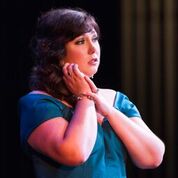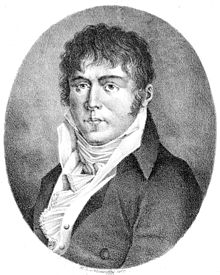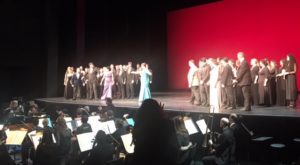
Giovanni Simone Mayr (1763-1845) is hardly the sexiest name in opera history, but he became exactly that between the hours of 4 and 8 p.m. on July 29 at Purchase College,
Make that 4:35 p.m. Mayr’s Medea in Corinto needed time to warm up.
Having written roughly 70 operas between 1794 and 1823, Mayr shows how Mozartean opera evolved without Mozart. An output of such volume could hardly be unknown, and it’s not. Any number of recordings are floating around – I previously encountered a number of them – and Medea in Corinto is the best known title among them.
The difference on Sunday was that the opera was in the hands of deeply sympathetic specialists, specifically Teatro Nuovo, the latest version of scholar/conductor Will Crutchfield’s bel canto-slanted workshop/mini-festival. Formerly at the Caramoor Festival, Crutchfield has migrated to the excellent facilities of Purchase College, which is a 45 minute drive out of New York City. The schedule includes Medea in Corinto repeated Aug. 4 in repertoire with Rossini’s Tancredi Aug. 3 and Tancredi Rifatto (the same opera with rewrites) Aug. 5.
One could easily assume that Mayr was a forerunner to Rossini and bel canto in general. But instead of being a beginning, Mayr’s mid-period, 1813 opera Medea in Corinto shows him as a classical/romantic transitional figure, and one whose aesthetic represents many of the elements swept away by Rossini’s world domination (as Crutchfield explained in his pre-concert lecture). Mayr’s combination of harmonic sophistication and orchestrally-accompanied recitatives points less to Rossini, at least to my ears, and more to Carl Maria von Weber, who ushered in romantic opera for real in 1821 with Der Freischutz.

In the first half hour or so, you sensed why Mayr has been neglected. Even in this, his most famous opera, the composer doesn’t put his best foot forward. Handel sometimes spent the entire first act of an opera clearing his throat, but did so lyrically. Mayr’s Medea begins with no distinctive melodic profile. Vocal lines had appropriate rhetoric timing that kept you from wishing you hadn’t come. However, the emotional panorama that is the Medea legend – where the spurned woman takes the ultimate revenge – became increasingly sharp with more melodically and dramatically memorable ideas. Act II has a series of confrontations and extended, detailed soliloquies that had to have been an influence on Beethoven’s Fidelio and certainly hold their own with the best in that more famous opera. You knew you were in the hands of a master.
Orchestrally, Mayr was on par with the symphonic Mozart and Haydn. So frequent and eloquent were the incidental solos that Medea in Corinto often sounded like a concerto for orchestra with a great plot. In fact, Act II of this semi-staged performance rightly put the harpist onstage with the singers since that soloist dominated the entire scene. Was Mayr more interested in the orchestration than dramatization? Did the orchestration keep him interested in the plot? Such theories holds water in light of the fact that Mayr knocked out three operas a year with libretti (this one by Felice Romani) that had been set to music by so many others.
I was glad that the opera wasn’t fully staged. Making sense out of the score theatrically might not be any great strain, but such a layer might get in the way of the marvelous directness one experienced in what had to be an initial encounter with the opera for many in this lamentably small audience. And that sense of directness may be more fragile than it seemed on Sunday. Returning home, my enthusiasm for the opera melted almost immediately upon re-visiting the opera in recordings. The Dynamic-label Medea conducted by Fabio Luisi looked like a good bet, but felt more like a grudgingly rehearsed obligation than a performance. Mozart and Haydn can survive that. Not Mayr, who suddenly sounded incredibly formulaic.
It would seem that the role of specialist performers at Purchase made a huge difference – and one that only became clear when its virtues are absent. Even in the most impressive moments, the specific components of Mayr’s music can seem a bit commonplace – until they’re infused with the relevance of whatever dramatic situation is at hand. And such relevance is greatly enhanced by hearing everything that’s going on in the orchestra, which was enabled greatly by the period-instrument Teatro Nuovo Orchestra. Supposedly, period orchestras appropriate to a romantic-era opera (50 or so pieces) can’t be heard in New York City unless John Eliot Gardiner is visiting. Not so anymore.
The Teatro Nuovo orchestra even had the long-outdated serpent (a tuba ancestor). The less varnished timbre of the instruments, particularly the brass, made the orchestral writing incredibly visceral, and having some highly expressive principal woodwind players contributed enormously to the total effect of the more introspective passages.

The pit-orchestra arrangement was somewhat circular: Some players actually faced each other – not unlike some of the arrangements Nicholas McGegan had for Handel operas in this theater back in the days of the Pepsico Summerfare. Clearly, the arrangement was in the interest in playing with a kind of chamber-music interaction since there was no traditional conductor: Jonathan Brandani cued the singers from the cembalo while first violinist Jakob Lehmann looked after the instrumentalists, some of whom shuttled in and out of the raised orchestra pit to enable any number of highly effective offstage effects. There are few conductors that I trust more than Luisi (who is on the Dynamic recording). But is it possible that even he got in the way?
Comparisons with recordings also showed that responsible singing is essential. You’ll notice I didn’t say great singing: Medea isn’t a star vehicle in the bel canto sense, but had to have been created on the assumption that the singers would be first class. Even when the Teatro Nuovo cast wasn’t vocally distinguished, the singers knew what they were about, dramatically and stylistically, plus knowing how the two can fuse together. And much of the singing was indeed distinguished. Coloratura tenors don’t grow on trees, but Derrek Stark (Jason) seems to be the real thing .Elena Snow (Ismenel) is a mezzo-soprano to watch. The obligatory second tenor in this genre was the lyrical role of Egito, sung by Mingjie Lei with a soft-grained tone and lyricism that had to have walked off with the hearts many in the audience.
The right singer in the central role is, of course, essential and that would be Jennifer Rowley. She has been making her name in roles such as Tosca. She stood in for Sonya Yoncheva in a high-profile concert performance of Tosca this spring with Yannick Nezet-Seguin and the Philadelphia Orchestra. I was there, and a steep growth curve was apparent between those first and last performances: Vocally capable but theatrically unsophisticated on opening night, Rowley evolved by the third performance into a Tosca any international opera house would want.
Medea in Corinto is far more challenging on every level. The role is longer and requires far more vocal athleticism. Once warmed up, Rowley sailed through the dips, curves and dramatic crises with a lush tone and temperamental fearlessness. As each new horror unfolds in the opera’s plot, Mayr and Rowley seemed to conspire to telegraph to the audience what was around the next corner – and make you dread it all the more. Good! If Rowley hasn’t yet had a career-making performance, this is it. This hearty Cleveland girl has playfully referred to herself as La Rowley (in reference to the 19th century show of respect to great divas). But she has now earned that title. One can call her La Rowley without irony.
Medea in Corinto cast with period orchestra taking bows


